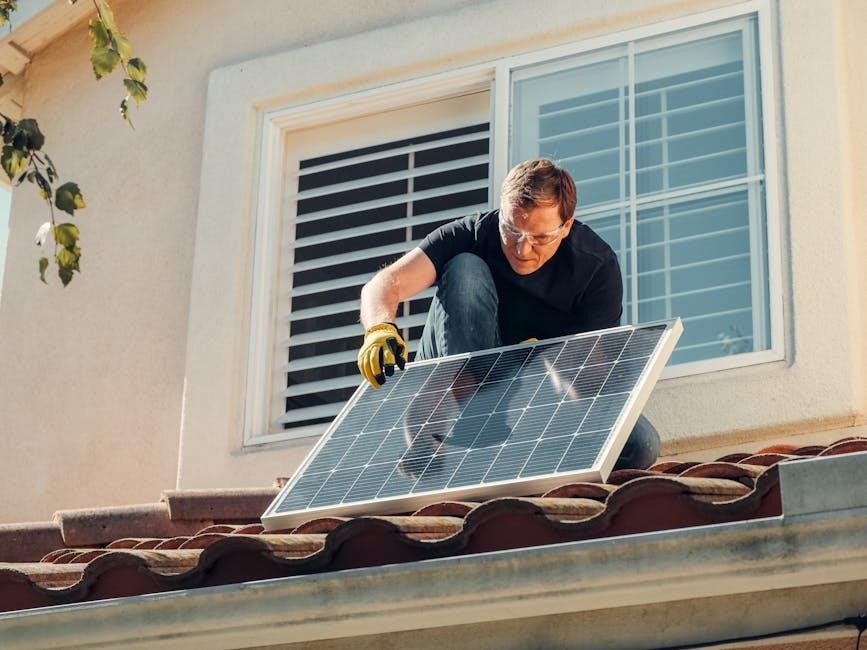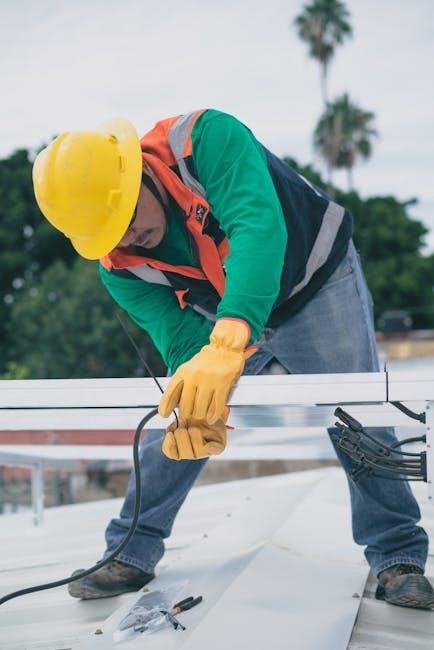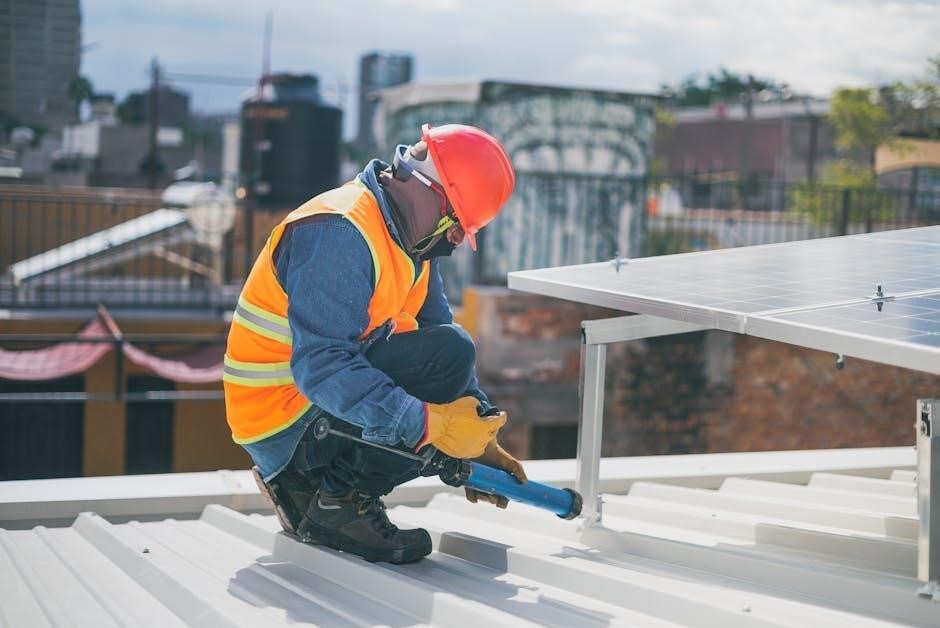generac 24kw installation manual
This manual provides comprehensive guidance for installing a Generac 24kW generator, ensuring safety, compliance, and efficiency. It covers essential steps, from site preparation to final testing.
1.1 Overview of the Generac 24kW Generator
The Generac 24kW generator is a high-capacity standby power solution designed for whole-house backup, offering reliable energy during outages. It operates on natural gas or propane, ensuring consistent performance. With a robust design, it handles heavy loads, including HVAC systems and major appliances. This model is known for its efficiency and durability, making it a popular choice for residential and light commercial use. Its compact size and quiet operation enhance user convenience. The generator is equipped with advanced features like automatic startup and load shedding, ensuring seamless power transition. Compliance with safety and emissions standards further underscores its reliability and environmental friendliness.
1.2 Importance of Proper Installation
Proper installation of the Generac 24kW generator is crucial to ensure safety, efficiency, and compliance with local regulations. Incorrect installation can lead to hazards such as carbon monoxide poisoning, electrical fires, or equipment damage; Adhering to the manual guarantees optimal performance and longevity of the system. It also ensures compliance with safety standards and manufacturer guidelines, which are essential for warranty validity. A professional installation by a certified technician is highly recommended to avoid potential risks and ensure the generator operates as intended during power outages. Proper setup also guarantees seamless integration with your home’s electrical system, providing reliable backup power when needed most.

Safety Precautions and Guidelines
Always follow safety standards to prevent hazards. Wear protective gear, ensure proper ventilation, and adhere to manufacturer guidelines to avoid risks during installation and operation.
2.1 General Safety Tips for Generator Installation
Ensure proper ventilation to avoid carbon monoxide buildup. Never install in enclosed spaces without vents. Keep flammable materials away. Always turn off power before handling electrical components. Ground the system correctly to prevent shocks. Use the correct tools to avoid damage. Follow local building codes strictly. Regular maintenance is crucial for safety and efficiency. If unsure, consult a licensed electrician. Keep children and pets away during installation. These precautions ensure a safe and reliable installation of your Generac 24kW generator. Always refer to the manual and local regulations for compliance. Safety should never be compromised during installation or operation.
2.2 Personal Protective Equipment (PPE) Requirements
Always wear appropriate PPE during installation to ensure safety. This includes safety glasses, gloves, and a hard hat. Steel-toe boots are recommended for protection against heavy objects. Use insulated tools to prevent electrical shocks. A respirator may be necessary in dusty or confined spaces. Ensure proper fitting of all PPE to maximize protection. Regularly inspect PPE for wear and tear; Never compromise on safety gear, as it is vital for protecting against electrical hazards, flying debris, and other risks. Adhere to local safety regulations and guidelines for PPE use. Proper PPE ensures a safe and injury-free installation process for the Generac 24kW generator.

Tools and Materials Needed
Essential tools include wrenches, screwdrivers, pliers, and drills. Materials needed are copper piping, wiring, connectors, sealants, and fasteners for secure installation.
3.1 Essential Tools for Installation
The installation of a Generac 24kW generator requires specific tools to ensure safety and efficiency. Essential tools include adjustable wrenches, screwdrivers (both flathead and Phillips), pliers, wire cutters, and a multimeter for electrical connections. A drill with various bits is necessary for making holes in surfaces. Additionally, a level, torque wrench, and pipe cutter are crucial for proper alignment, tightening, and gas line setup. Safety tools like gloves and safety glasses should also be on hand. Having all these tools ready ensures a smooth and professional installation process, avoiding delays and potential errors.
3.2 Required Materials and Components
The installation of a Generac 24kW generator requires specific materials to ensure proper functionality and safety. Key components include a transfer switch compatible with the generator’s power rating, a gas line kit with appropriate fittings, and weatherproof electrical connectors. Additionally, you’ll need heavy-duty wiring sized for the generator’s output, circuit breakers, and mounting hardware for securing the unit. A drain kit for the fuel system and a grounding kit are also essential. Make sure all materials are rated for outdoor use and comply with local electrical codes. Properly gathering these components beforehand ensures a smooth installation process and minimizes potential delays.

Site Preparation
Site preparation involves selecting a level, well-ventilated area for the generator, ensuring compliance with local codes, and preparing the ground to support the unit’s weight safely.
4.1 Choosing the Right Location for the Generator
Choosing the right location for your Generac 24kW generator is crucial for optimal performance and safety. The unit should be installed on a firm, level surface, away from direct sunlight and moisture. It must be at least 18 inches away from any combustible materials and positioned to ensure proper ventilation. Additionally, the location should provide easy access for maintenance and servicing. Local building codes and regulations must be consulted to ensure compliance. The generator should also be placed in an area that minimizes noise disturbance to occupants and neighbors. Proper placement helps prevent potential hazards and ensures reliable operation.
4.2 Ensuring Compliance with Local Building Codes
Ensuring compliance with local building codes is essential for a safe and legal installation of your Generac 24kW generator. Begin by consulting local regulations regarding generator installations, which may include permits, inspections, and specific placement requirements. Verify setback distances from property lines, neighboring structures, and sensitive areas like windows or vents. Ensure the installation meets fire safety standards and proper venting guidelines. Failure to comply can result in fines, installation delays, or even denial of service. Always work with licensed professionals familiar with local codes to guarantee adherence and avoid potential legal or safety issues. Compliance ensures a reliable and hazard-free operation of your generator.

Installation Steps
Follow detailed instructions for placing and leveling the generator, installing the transfer switch, and connecting fuel lines. Ensure all steps align with the manual and local codes for safety and efficiency.
5.1 Placement and Leveling of the Generator
Proper placement and leveling are crucial for the Generac 24kW generator’s operation. Choose a well-ventilated, dry location, ensuring compliance with local building codes; Use a level to ensure the generator is perfectly horizontal to avoid vibration and noise. The surface should be firm and even, preferably a concrete pad. Keep the generator at least 18 inches away from any flammable materials. Ensure the area is clear of debris and obstructions for proper airflow. Correct leveling prevents oil leakage and ensures optimal performance. Follow the manufacturer’s guidelines for anchoring the unit to withstand environmental stresses.
5.2 Installing the Transfer Switch
Installing the transfer switch is a critical step in the Generac 24kW installation. The transfer switch must be placed between the main electrical panel and the generator, ensuring it is easily accessible. Shut off the main power supply before starting the installation; Connect the transfer switch to the generator, following the wiring diagram provided in the manual. Secure all connections tightly to prevent loose wires. Ensure the transfer switch is properly grounded to avoid electrical hazards. Once installed, test the switch to confirm it operates smoothly, transferring power between the grid and the generator. Always consult a licensed electrician if unsure.

Electrical Connections
Ensure all electrical connections are made safely and securely, following the wiring diagram in the manual. Verify proper grounding and compliance with local electrical codes.
6.1 Connecting the Generator to the Transfer Switch
Connect the Generac 24kW generator to the transfer switch by following the wiring diagram in the manual. Ensure all terminals are securely fastened and properly labeled. Verify that the transfer switch is rated for the generator’s power output. Double-check the connections for polarity and phase alignment. Turn off the main power supply before making any connections. Use appropriately sized cables to prevent overheating. Refer to local electrical codes for compliance. Test the connections with a multimeter to ensure continuity and absence of short circuits. Properly ground the system to avoid electrical hazards. Consult a licensed electrician if unsure about any step.
6.2 Wiring the Transfer Switch to the Main Electrical Panel
Connect the transfer switch to the main electrical panel by ensuring all wires are correctly sized and rated for the generator’s output. Turn off the main power supply before starting. Use the wiring diagram provided in the manual to identify the correct terminals for connection. Securely fasten all connections to avoid loose wires. Ensure the transfer switch is properly grounded to prevent electrical hazards. Verify that the wiring complies with local electrical codes and regulations. Double-check the polarity of each connection to maintain proper circuit functionality. Test the system with a multimeter to confirm continuity and absence of short circuits. Consult a licensed electrician if unsure.

Fuel System Installation
Install the fuel system by connecting the gas line to the generator, ensuring proper sizing and compliance with local codes. Secure all connections tightly to prevent leaks and ensure safe operation. Use approved materials for fuel line installation to maintain durability and safety. Refer to the manufacturer’s specifications for correct installation procedures. Ensure the fuel supply is adequate for the generator’s capacity. Consult a professional for gas line hookups to avoid hazards. Regularly inspect the fuel system for any signs of damage or wear. Follow all safety guidelines to prevent fuel-related risks during installation and operation.
7.1 Setting Up the Gas Line
Setting up the gas line for your Generac 24kW generator requires careful planning and adherence to safety protocols. Ensure the gas line is properly sized to meet the generator’s fuel demands, as specified in the manual. Use approved materials and fittings to prevent leaks and corrosion. Consult local regulations for compliance, and hire a licensed professional for installation if necessary. Properly connect the gas line to the generator’s fuel inlet, ensuring all connections are secure and leak-free; Conduct a pressure test before finalizing the setup. Ensure the gas supply is adequate for the generator’s capacity to avoid operational issues. Follow the manufacturer’s guidelines for fuel line installation to guarantee safe and efficient operation.
7.2 Connecting the Fuel Line to the Generator
Connecting the fuel line to the Generac 24kW generator is a critical step requiring precision. Attach the fuel line to the generator’s inlet port, ensuring compatibility with the fuel type (natural gas or propane). Use approved fuel line connectors and sealants to prevent leaks. Tighten all connections securely, following the torque specifications provided in the manual. After installation, perform a leak test using a soap solution or electronic detector to ensure integrity. Ensure the fuel line is properly routed away from heat sources and electrical components. Consult a licensed technician if unsure about any step. Proper connection ensures safe and efficient generator operation. Always follow local codes and manufacturer guidelines for a reliable setup.

Testing and Commissioning
Testing and commissioning involve initial startup, verifying power output, transfer switch functionality, and load tests to ensure smooth, efficient operation during power outages and safe performance.
8.1 Initial Startup and Testing
Initial startup involves powering on the generator and checking basic functions. Ensure the unit runs smoothly, monitoring voltage, frequency, and RPM. Verify the transfer switch activates correctly during a simulated power outage. Check for any unusual noises or vibrations. Test the automatic shutdown features, such as low oil pressure or overload protection. Confirm proper communication between the generator and the transfer switch. Use the manual or digital controls to cycle the unit on and off. Record any issues or malfunctions encountered during testing. Ensure all safety features function as intended. This step ensures reliability before proceeding to load testing.
8.2 Load Testing the Generator
Load testing evaluates the generator’s performance under actual household or business demands. Start by connecting essential loads, such as lighting and appliances, and gradually increase to full capacity. Monitor voltage, frequency, and power output to ensure stability. Check for any signs of strain, such as overheating or reduced efficiency. Verify that the generator can handle the maximum load without tripping or shutting down. Use a load tester or a qualified technician to simulate real-world scenarios. Record the results to confirm the system meets specifications. This step ensures the generator can reliably power your home or business during outages.

Maintenance and Upkeep
Regular maintenance ensures optimal performance and longevity. Schedule annual professional inspections, change oil and filters, and inspect the battery and connections. Follow the manufacturer’s maintenance schedule.
9.1 Regular Maintenance Schedule
A well-structured maintenance schedule is crucial for ensuring the reliability and efficiency of your Generac 24kW generator. Regular tasks include oil and filter changes every 100 hours or annually, whichever comes first. Inspect the battery terminals and connections to prevent corrosion and ensure a stable power supply. Check the air filter and replace it as needed to maintain proper airflow. Verify the coolant level and top it off if necessary. Always refer to the manual for specific maintenance intervals and guidelines. Additionally, schedule an annual professional inspection to identify and address potential issues before they become critical. This routine ensures optimal performance and extends the lifespan of your generator.
9.2 Troubleshooting Common Issues
Troubleshooting your Generac 24kW generator involves identifying and resolving common issues promptly. Low battery voltage can indicate a faulty battery or charging system. Check connections for corrosion and ensure the battery is fully charged. If the generator fails to start, verify the circuit breaker or fuse. Overheating may occur due to blocked air vents or a malfunctioning coolant system. Regularly inspect the fuel line for leaks or obstructions. If the generator operates intermittently, check the transfer switch and electrical connections. For persistent issues, consult the manual or contact a certified technician. Addressing these problems early prevents downtime and ensures reliable performance during power outages.

Local Codes and Permits
Ensure compliance with local building codes and regulations. Obtain necessary permits before installation. Verify requirements for inspections and approvals to avoid delays or penalties.
10.1 Understanding Local Regulations
Understanding local regulations is crucial for a compliant Generac 24kW generator installation. Verify requirements with your local building department, including permits, inspections, and code standards. Ensure adherence to zoning laws, noise ordinances, and environmental regulations. Familiarize yourself with the National Electric Code (NEC) and any state-specific amendments. Check for emission standards and fuel usage restrictions. Proper documentation and approvals are essential to avoid installation delays or penalties. Consulting with local authorities or a licensed professional can help navigate complex regulations. Compliance ensures safety, legal operation, and optimal performance of your generator system. Always prioritize local guidelines to avoid potential fines or system shutdowns.
10.2 Obtaining Necessary Permits
Obtaining the necessary permits is a critical step in the installation process of a Generac 24kW generator. Contact your local building department to determine the required permits, which may include electrical, plumbing, and zoning permits. Submit a detailed installation plan, including site plans and technical specifications, for approval. Ensure all fees are paid and inspections are scheduled as required. Failure to obtain proper permits can result in fines or installation delays. A licensed professional can assist with the permitting process to ensure compliance with local regulations. Always maintain records of permits and inspections for future reference. Compliance ensures a safe and legally approved installation.
